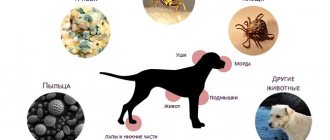What is cystitis?
Cystitis - known in professional parlance as cystitis - is nothing more than an increased presence of microorganisms in the urinary tract, which leads to inflammation. The disease affects the lower urinary tract: the urethra (Urethra) and bladder (Vesica urinaria).
As with any inflammation, this is the body's reaction to harmful irritants, which is expressed in redness, pain and dysfunction.
Typically, bacteria cause cystitis in dogs. However, viruses and fungi, such as Candida albican, or parasites, such as Capillaria plica, which cause capillary urinary tract disease, can also be a cause, although not as often.
Why dogs can develop cystitis
Cystitis does not develop out of nowhere. Among the reasons why inflammation of the urinary reservoir may begin are usually:
- Hypothermia - it is enough for a dog to swim in a cool pond, walk in the autumn rain or doze off on a concrete floor for cystitis to begin;
- Complications after genitourinary diseases - urolithiasis, nephritis, urethritis, etc.;
- Gynecological problems in bitches – pyometra, vaginitis, metritis;
- Parasites operating in the dog’s bladder or other genitourinary organs (Trichomonas, giant pileworms, etc. worms and unicellular organisms);
- Bacterial, fungal and viral infections (herpesvirus, candidiasis, leptospirosis, etc.);
- Inflammatory processes of any nature (caries, laryngitis, gastritis, etc.);
- Poor and vitamin-poor nutrition or increased overeating are processes that disrupt metabolism and the condition of the genitourinary system;
- Injuries to the genitourinary organs as a result of road accidents, impacts, falls from a height;
- Stress that negatively affects the entire body and the bladder in particular.
Chronic cystitis in dogs
If a dog has a urinary tract infection more than twice in a six month period or more than three times a year, it is chronic cystitis. This condition has two forms: recurrent and reinfectious.
In case of relapse, the microbes survive in the lower urinary tract. This happens, for example, when the medicine is chosen incorrectly or the dose is too small, but also in the case of resistant bacteria.
During re-infection within a year, new inflammations appear with completely new microbes that are not responsible for the primary inflammation. This may be due to a weakened immune system.
Chronic cystitis requires a thorough examination of the dog to determine the trigger. In addition to anatomical reasons, treatment errors should also be taken into account.
Cystitis - known in professional parlance as cystitis - is nothing more than an increased presence of microorganisms in the urinary tract, which leads to inflammation.
Symptoms of cystitis in dogs
Typical symptoms of canine cystitis resemble those found in humans: increased urge is associated with poor performance.
In other words: the dog still wants to go outside, but despite strenuous attempts, he only manages to squeeze out a few drops, and the urination lasts longer than usual. This is sometimes accompanied by characteristic stooping and painful sounds caused by pain. In addition to unusual behavior that indicates pain, cystitis in a dog also reveals the appearance of urine, both in terms of color and texture and smell.
Urine may contain blood, causing it to be reddish, often appear cloudy, and sometimes foam slightly. It also has a more intense smell than usual. If the bladder infection is severe or chronic, it can negatively affect the kidneys or renal pelvis, leading to fever, fatigue and weakness.
Signs and symptoms of cystitis in puppies
- Frequent urination.
- The amount of urine is small, sometimes mixed with blood and mucus.
- Painful emptying of the bladder - the puppy whines when trying to pee.
- Irritation, swelling or pustular rashes in the genital area.
- Frequent hygiene of the puppy around the urethra.
The complex of signs of cystitis in a puppy can be cause for concern, so it needs to be shown to a specialist for diagnosis and treatment.
Ignoring symptoms leads to a chronic form. She is dangerous due to diseases of the genital organs and the inability to bear healthy offspring. Cystitis is more common in female puppies.
Causes of cystitis in dogs
The risk of cystitis increases when a dog is exposed to cold conditions for long periods of time. Long walks on damp, cold days, when the wet coat does not have time to dry, are very harmful, as well as long baths in cold water on hot summer days promote the growth of bacteria.
Cystitis in dogs, especially breeds such as Doberman, German Shepherd, and Beagle, can, although less frequently, have anatomical and other non-infectious causes. These include:
- urinary stones and crystals in urine
- narrowed urethra
- Incorrect ureteral alignment
- weakened immune system
- mechanical injuries
- taking medication
- polyps or lumps
Symptoms of canine cystitis
To prevent the acute form of the disease from developing into a chronic one, any owner needs to know what the symptoms of cystitis are in a dog. So, the dog owner should be wary of the following things:
- Frequent urination (with cystitis, a dog can pee about 4 times or more in 1 hour);
- Change in the color of urine (instead of the usual light-straw urine, it becomes orange, and sometimes even red if there is an admixture in the form of blood);
- Change in the smell of urine (a sharp aroma with notes of ammonia may indicate cystitis);
- Pain during urination (the dog may whine pitifully when peeing);
- Males relieve themselves in an unusual sitting position;
- Frequent incontinence (puddles can be found on the floor, although this has not previously been observed in the animal);
- The dog's belly is tight, the dog does not allow himself to be stroked in the area from the chest to the groin;
- The animal's activity is reduced (the dog is not interested in games or walks);
- Decreased appetite due to severe thirst.
You should not expect that all of the listed symptoms are necessarily present in every dog suffering from bladder inflammation. At the beginning of the disease, it is not so easy to recognize this disease: the animal’s urge to go to the toilet may only become slightly more frequent. Therefore, it is important to correctly diagnose the disease before starting to take medications to treat cystitis.
Bacterial cystitis in dogs
Most cases of canine cystitis are bacterial in origin. Strains of Escherichia coli or colon bacilli are the most common culprits, but sometimes other bacteria also spread in the urinary tract. Staphylococcal, streptococcal, Klebsiella and Proteus mirabilis are usually more severe.
The vast majority of bladder diseases in dogs—about 80%—are caused by just one type of bacteria. In other cases, mixed infections occur. With cystitis, germs from the dog's genital area or gastrointestinal tract must reach the bladder through the urethra.
There they nest and breed. Inflammation can affect only the mucous membrane (urosistitis) or the entire wall of the bladder (panzistitis).
Prevention of cystitis
In tandem with a competent veterinarian and a caring attitude, it is possible to cure cystitis in a dog, but it is better to prevent the disease. Nothing extra complicated is required from the owner:
- Your pet should drink plenty and only clean water (filtered, from a bottle).
- You can't walk your dog twice a day, that's not enough. At least three times or you will have to put the tray down.
- You should not allow your pet to rest in a draft, near a fan, or on a tiled floor.
- The pet must have healthy gums and teeth (inflammation in the oral cavity is caused by bacteria that will certainly enter the urethra).
- While in heat, bitches should not be walked where strays walk. And under no circumstances should male dogs be allowed to lick a girl’s loop.
- Males should not be allowed to mate with untested females.
- For long-haired pets, the hair under the tail should be trimmed to prevent feces from accumulating and then falling into the mouth and onto the genitals (after licking).
But the main measure to prevent cysts in dogs is an annual visit to the veterinarian to monitor the general condition of your pet. It is enough to take a urine test to notice changes in the picture compared to previous results. And the financial expenses and time spent on an annual preventive visit to the clinic are nonsense compared to how much money, time and mental energy will have to be spent on treating your pet. In addition, it is always easier to defeat a disease if you catch the disease at an early stage - do not forget this simple truth.
Why do bitches have cystitis more often than cables?
The higher incidence of cystitis in female dogs is due to their body type: the smaller distance between the urethral and anal openings, but also due to a much shorter and wider urethra than that of cable dogs.
This allows bacteria to penetrate more easily and reach their destination faster. Spayed female dogs are also more prone to cystitis because they have lower estrogen levels.
Sex hormones perform an important protective function for the tissues of the urinary tract, producing important active substances, so-called peptides. As estrogen levels decrease, this natural barrier to harmful microorganisms becomes sensitive and more permeable. In addition, in spayed female dogs, the connective tissue relaxes more quickly: when the bladder sphincter is no longer sealed, it is easier for germs to get inside.
Treatment of cystitis in dogs
If your dog shows signs of cystitis, contact your veterinarian as soon as possible.
Lower urinary tract disease can not only be very painful, but also dangerous if left untreated. If bacterial cystitis occurs, he faces dangerous inflammation of the renal pelvis. If bacteria is found in the urine, the veterinarian will usually prescribe an appropriate antibiotic and possibly analgesics and anti-inflammatory drugs.
If the urinary tract infection is not contagious, your veterinarian can use ultrasound or x-ray to determine whether cystitis is caused by urinary tract defects, urolithiasis, or cancer.
What can cure a sick dog?
For bacterial cystitis, in addition to drug treatment, you should make sure your dog drinks a lot and urinates frequently.
This cleanses the bladder and causes most bacteria to be automatically eliminated. Since it is impossible to force your dog to drink more often, it is better to add water to his regular food - this is a proven method. Warmth is also very important: your dog should not be exposed to drafts, moisture or cold to avoid overtaxing the immune system.
Wet floors or cold tiles are definitely not recommended. If it is an E. coli infection and you are using home treatment, you can give your dog D-mannose. It is a naturally occurring substance, a type of simple sugar, to which bacteria attach “more readily” than to the wall of the bladder.
In this way, germs are removed from the urinary tract along with the excreted sugar during urination.
Can you prevent cystitis in your dog?
You can only prevent—and only partially—a bacterial bladder infection. On the one hand, it is important for the dog to get fluids regularly, and on the other hand, it is important to empty the bladder regularly.
Drinking water flushes your bladder, and urinating frequently without having to hold it for long periods of time prevents bacteria from growing in the urinary tract.
Hypothermia must be strictly avoided: wet fur combined with a draft contributes to the development of bacterial cystitis. Preventative D-mannose is recommended for particularly sensitive dogs.
A healthy diet strengthens the immune system and can therefore reduce the risk of inflammation.
Causes of cystitis
In 70% of cases, bacteria are the culprits of the disease. They can enter the bladder mucosa in two ways - descending and ascending. In the first case, bacteria enter the bladder with the lymph flow from neighboring organs or with the blood flow (from anywhere, even from inflamed gums and carious pulp). With a descending route of penetration, treatment with antibiotics is not always effective, because First of all, it is important to eliminate the main source of infection.
The ascending path is penetration from the outside, through the urethra. There are always bacteria in the urethra, but they are washed out by urine. If the pet suffers for a long time or its immunity is weakened (hypothermia, stress), bacteria begin to actively multiply and rise higher, from the urethra to the bladder. Girls get cystitis more often, because... The female's urethra is wider, shorter and located close to the anus - it is easier for bacteria to enter the bladder. In addition, bitches are susceptible to various “female” ailments that disrupt the flora (vaginitis and metritis).
Less commonly, cystitis develops against the background of parasitic infestation, toxic medications, allergies, or tumors. Cystitis as a symptom is observed in urolithiasis, nephritis and other diseases of the genitourinary system. If therapy for the underlying disease is not carried out or is ineffective, chronic cystitis cannot be treated.











